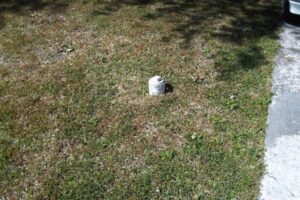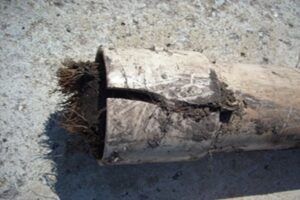Before it breaks down, you don’t realize how important a functioning toilet is. Seeing a large puddle at the bottom of your toilet when you enter your bathroom should prompt you to contact a plumber immediately. The toilet leaking around base is not only unhygienic, but it may also start causing water damage to the flooring and walls. But trust or not, a toilet that leaks at its base isn’t always as serious an issue as it may seem. Here are some reasons to examine why the toilet is leaking and what steps one can immediately take to stop the leak.
Why Does The Toilet Leak At The Base?
#1 Clogged drain line
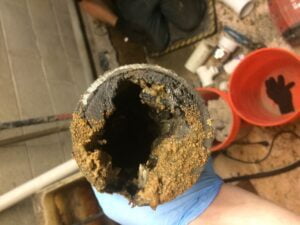
If the toilet is leaking at the base and the toilet gets clogged easily, it may be a sign that your drain line is clogged. The drain line transports the flushed water from the home. The strain exerted by a blocked drain line on the wax ring at the toilet base might cause it to break down and lead to toilet leaks. Call a plumber for an assessment if you believe this is the issue. They can quickly unclog the drain pipe and restore the operation of your toilet.
#2 The tee bolts require tightening
Two tee bolts fasten the toilet’s base to the floor. If these bolts loosen, the toilet will likely shake, leading the wax ring’s seal to mess up. So, the loose tee bolts may cause drain water to leak at the base each time you flush it. Tightening the tee bolts might resolve the issue if this is the sole reason.
#3 The wax ring needs replacement
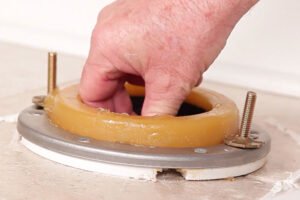
Typically, the wax ring needs replacement since this toilet is loose. Another cause why a wax ring may need replacement is because it has become weak over time. This indicates that the seal has been compromised. This can result in toilet leaking around base.
#4 A faulty water supply line
If the water supply line leaks, water will start leaking from the toilet base at all times, not only when the toilet is flushed. Inspect the connection between the supply system and the tank to ensure that the nut and rubber sealing is secure.
#5 Water condensing and dripping
The water inside the tank and bowl of a toilet is typically cold, as is the ceramic. A humid environment will cause the water to drop from the ceramic on the bowl, causing water to collect at the bottom of the toilet.
#6 Damaged Toilet Bowl
Toilet bowls are durable, although accidents may occur, resulting in occasional cracking. Usually, microscopic fractures are minor, but if they penetrate far enough, they might cause leakage at the base of the toilet.
How To Fix Toilet Leaking Around Base?
#1 Inspect For Condensation
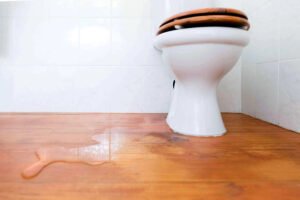
Before you begin your toilet repair task, examine the exterior of the toilet bowl to ensure that the issue is not caused by condensation.
If condensation is the cause of the issue, consider the following ways to prevent water from pooling at the bottom of your toilet:
- Set up a tray.
- Insulate the water storage tank.
- Ensure that your flapper is not defective.
- Take showers that are shorter and colder, and switch on the fan.
If this isn’t the issue, resume your search for the root cause.
#2 Tighten all Tee Bolts
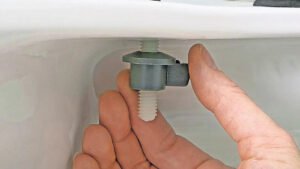
Remove the plastic caps from the toilet’s base on both ends. To secure the tee bolts, choose an adjustable open-end spanner with an open end. When the toilet is tightened against the floor, the wax ring that closes the toilet drainage outlet is compressed. If the tee bolts are already secure or cannot be tightened further, removing the toilet and reinstalling a new wax ring and new bolts may be necessary.
#3 Disconnect and remove the toilet
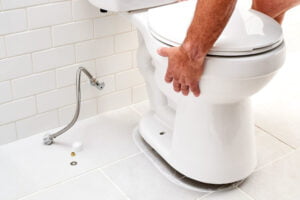
Turn off the water supply to the toilet before detaching it. The shutdown valve often lies to the left of the toilet, next to the water system tubing and the water valve toilet.
- Flush the toilet to remove all fluid from the bowl and tank. Use a towel or cloth to eliminate extra water from the tank and toilet bowl.
- Disassemble the nut that connects the supply tubing to the fill valve tailpiece with a screwdriver.
- Disconnect the tee bolts nuts from the toilet bottom using your tool. If you find the tee bolts rusty and wouldn’t spin, you might have to use a hacksaw to cut each one.
- Lift the commode upwards and out of the floor drain to remove the toilet. Instead of trying to move the toilet by yourself, it may be preferable to have help.
- To avoid damage, turn the toilet over its side.
#4. Removing the old wax ring and installing a new one
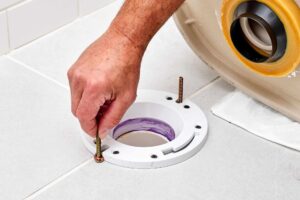
Strip the wax ring and replace it with a new one. Using a putty knife, remove the old wax surrounding the drain hole. Ensure that you remove all the old wax properly. Then, put in the new one. The ring will be positioned such that the plastic cone faces the drain. Ensure the exact placement of the tee bolts in the keyholes on either side of the flanges.
#5 Install the Toilet again
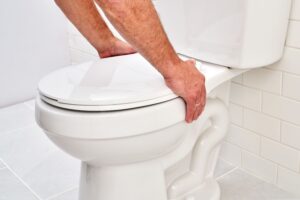
Gently lift the toilet and reposition it over the drainage to ensure that the tee bolts may properly fit through the openings in the toilet’s bottom. Push the toilet over the wax ring while gently swaying it so that the toilet compacts the wax to establish a tight seal. Using a wrench, secure the nuts and tee bolts, taking care not to over tighten them, as this might cause the ceramic to break.
#6 Restore the water supply line
Turn the water supply on after reconnecting the water supply tube to fill the valve. After the toilet tank fills, flush the toilet and check for leaks. Caulk the bottom of your toilet after you are sure there is no leakage.
Conclusion
Some bathroom plumbing issues are out of your control. Alleviate your concerns and worries about plumbing issues after hiring a professional plumber. You can be sure your toilet leaking around base will be repaired the first time properly if you hire a qualified plumber. Rooter-Man, the leading plumbing service in Charleston SC, can help you resolve your concerns in the first place.





